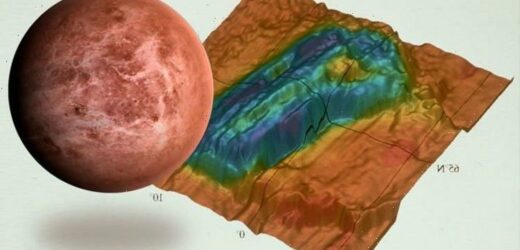Venus: Life could be discovered by spacecraft says scientist
We use your sign-up to provide content in ways you’ve consented to and to improve our understanding of you. This may include adverts from us and 3rd parties based on our understanding. You can unsubscribe at any time. More info
In recent years, Venus has renewed the interest of scientists after the discovery of gas. Phosphine — a potential marker of life — was detected in the atmosphere last year. Signs of the gas were detected way back in 1978, but were quickly forgotten about.
Venus has been widely considered a dead planet for many years, its environment undergoing a radical and lethal shift, its atmosphere made up mainly of carbon dioxide and thick clouds of sulfuric acid completely.
Yet, recent research suggests this may be far from the truth.
Another look at data from the Magellan spacecraft, which was launched in 1989 to map the surface of Venus, has found that volcanism could still be occurring on the planet today — a clear sign that the planet is active.
Magellan spent five years spanning the planet, and is considered one of NASA’s most successful deep space missions, making several vital discoveries.


Researchers revisited the data it collected using techniques not available when the spacecraft visited Venus all those years ago.
The large-scale analysis was explored by BBC Sky At Night magazine.
Megan Russell, from the Planetary Science Institute who led the study, said: “Instead of looking at the surface of the volcano or flows, we look at how it defames the ground around it.
“From this deformation we can infer properties like heat flow local to the volcano.”
JUST IN: Gas boiler ban: Millions of Britons face £5,000 bill

From the shape of these features, Ms Russell’s team could discern that they may have formed within the last few tens of millions of years.
This is considered recent in geological terms.
Vitally, it could suggest that the volcanoes could even still be growing.
Whatever the soon-to-be conclusion is, it appears that volcanism has been happening on Venus more recently than previously believed.
In fact, last year, a study led by researchers at the University of Maryland and the Institute of Geophysics at ETH Zurich suggested that Venus is home to at least 37 recently-active volcanic structures.
DON’T MISS
Pompeii breakthrough as ‘sensational discovery’ made near Roman town [REPORT]
UK fires back after EU bans Britain from £80bn project [INSIGHT]
Putin outsmarted after offering to ‘rescue’ UK from gas crisis [ANALYSIS]


It marked the first evidence before Ms Russell’s recent analysis that the interior of the planet is still geologically active.
Previous studies have found evidence of a warm interior and ring-like structures known as coronae.
These form when plumes of hot material deep inside the planet rise through the mantle layer and crust in a manner similar to the way mantle plumes formed the volcanic Hawaiian Islands.
It was thought that these were signs of ancient activity, and that the planet had cooled enough to slow down geological activity in the planet’s interior and harden the crust so much that any warm material from deep inside would not be able to puncture through.


But the 2020 study saw researchers create models of thermal activity beneath the surface of Venus to create high-resolution, 3D simulations of coronae formation.
They then used these to identify features that are present only in recently-active coronae, later looking for similar structures on the surface of Venus.
Laurent Montési, a professor of geology at the University of Maryland, told Science Focus: “This is the first time we are able to point to specific structures and say ‘Look, this is not an ancient volcano but one that is active today, dormant perhaps, but not dead.

“This study significantly changes the view of Venus from a mostly inactive planet to one whose interior is still churning and can feed many active volcanoes.”
Researchers then mapped out the active coronae on Venus, and found that they are largely clustered together in a handful of locations.
Suggesting where the plant is most active, it may help identify target areas where geologic instruments should be placed on future missions to Venus.
In 2032, Europe’s EnVision is scheduled to launch towards the second planet from the Sun.
You can subscribe to Sky At Night here.
Source: Read Full Article

